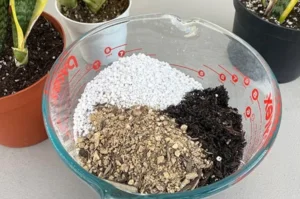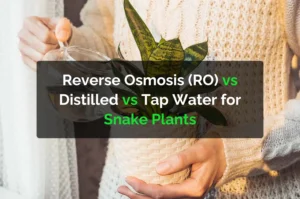Snake plants (Sansevieria) are beloved for their striking, upright leaves and low-maintenance care. However, to keep your snake plant thriving and growing optimally, proper fertilization is key. In this guide, we’ll explore the best fertilizers for snake plants, how often to fertilize, common mistakes to avoid, and expert tips to maximize your plant’s health.
What is the Best Fertilizer for Snake Plants?
The best fertilizer for snake plants is a balanced or slightly nitrogen-rich formula, such as a 10-10-10 or 10-15-10 liquid fertilizer. Apply it once every 2-3 months during the growing season, using a diluted solution to prevent over-fertilization.
Why Fertilize Your Snake Plant?
While snake plants are hardy and can survive in low-nutrient soil for a long time, fertilizing offers several benefits:
- Boosts Growth: While slow-growing, a well-fed snake plant will develop stronger and lusher leaves.
- Enhances Leaf Color: The right nutrients enhance the deep green hues and variegation of the leaves.
- Promotes Flowering: Though rare, proper fertilization increases the chances of a snake plant producing small, fragrant flowers.
- Strengthens Resistance: A healthy, well-nourished plant is more resistant to pests and diseases.
Understanding Fertilizer Basics
Every fertilizer has an N-P-K ratio that represents the percentage of Nitrogen (N), Phosphorus (P), and Potassium (K). These nutrients serve different purposes:
- Nitrogen (N) – Promotes healthy foliage growth and deep green coloration.
- Phosphorus (P) – Supports strong root development and enhances flowering potential.
- Potassium (K) – Boosts overall plant health and resistance to diseases.
Best Fertilizers for Snake Plants
When choosing a fertilizer, consider these top recommendations:
1. Balanced Liquid Fertilizer (10-10-10 or 20-20-20)
- Why? Provides a uniform supply of nutrients.
- Recommended Brand: Miracle-Gro Indoor Plant Food (Liquid).
- Application: Mix with water according to the instructions and apply once every 2-3 months.
2. Low-Nitrogen Fertilizer (10-15-10 or 5-10-10)
- Why? Snake plants prefer moderate nitrogen levels to prevent excessive leaf growth at the expense of root development.
- Recommended Brand: Schultz 10-15-10 Plant Food.
- Application: Dilute in water and apply once every 3 months.
3. Organic Fertilizer (Compost Tea, Worm Castings, or Fish Emulsion)
- Why? Provides slow-release nutrients and improves soil microbiology.
- Recommended Brand: Dr. Earth Organic Indoor Plant Food.
- Application: Apply every 4-6 months to replenish soil nutrients naturally.
How Often Should You Fertilize a Snake Plant?
The frequency of fertilization depends on the light conditions your plant receives:
- High Light: Fertilize every 2-3 months.
- Medium Light: Fertilize twice a year (spring and summer).
- Low Light: Fertilize once a year.
Over-fertilizing can lead to fertilizer burn, causing browning tips and yellow leaves, so always follow recommended dosages.
How to Fertilize a Snake Plant – Step-by-Step Guide
Step 1: Choose the Right Fertilizer
Select a balanced or slightly phosphorus-rich fertilizer to encourage strong growth.
Step 2: Prepare the Fertilizer Solution
If using liquid fertilizer, dilute it as per the product instructions. For granular options, mix into the topsoil lightly.
Step 3: Apply Fertilizer Properly
- For potted plants with drainage holes: Water thoroughly after applying liquid fertilizer to distribute nutrients evenly.
- For pots without drainage holes: Use less water and fertilize sparingly to prevent root rot.
Step 4: Monitor for Over-Fertilization
Signs of over-fertilization include:
- Browning leaf tips.
- Wilting or soft leaves.
- Salt buildup on the soil surface.
If this occurs, flush the soil by running clean water through the pot to remove excess nutrients.
Common Mistakes to Avoid
❌ Using Too Much Fertilizer – Always follow label instructions and err on the side of caution.
❌ Fertilizing in Winter – Snake plants enter dormancy in colder months and don’t require extra nutrients.
❌ Assuming Fertilizer Fixes All Problems – If your plant has yellowing leaves, check for watering issues before adding fertilizer.
Frequently Asked Questions (FAQs):
Can I use coffee grounds as fertilizer for my snake plant?
No, coffee grounds are too acidic and can cause root damage over time.
What’s the best time of day to fertilize?
Morning or early evening is best, so the snake plant has time to absorb nutrients without stress.
Can I use succulent fertilizer for my snake plant?
Yes! A balanced cactus or succulent fertilizer works well since snake plants prefer light feeding.
Final Thoughts
Fertilizing your snake plant is an easy way to boost its health, promote growth, and even encourage flowering. Stick to a simple fertilization routine using a balanced liquid or slow-release fertilizer, and avoid overfeeding. With the right care, your snake plant will remain a stunning, low-maintenance addition to your indoor space!






